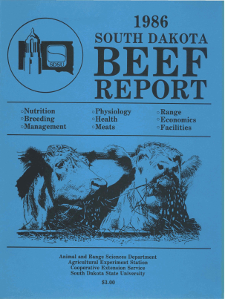
South Dakota Beef Report, 1986
Document Type
Report
Report Number
86-14
Publication Date
1986
Keywords
feeder steers, preconditioning, performance, health, energy level, implanting
Summary
Four hundred steer calves were used to determine the effect of preconditioning on performance and health of calves fed either a high or low energy diet. In each of 2 years, 200 steer calves were selected from four western South Dakota ranches to participate in the study. Preconditioned (PC) calves were treated according to the South Dakota Beef Cattle Improvement Association and Cooperative Extension Service's guidelines for the "Green Tag" program. Preconditioning and implanting with zeranol produced a heavier calf at market time. No difference in weight loss during transit was noted between the PC and control treatments (CO), but implanted calves lost more weight than those not implanted (5.51 vs 4.92%). Preconditioned calves gained faster (3.04 vs 2.68 lb/head/day) and consumed more dry matter (13.94 vs 11.98 lb/head/day) the first 28 days in the feed lot than CO. Implanted calves had improved average daily gain (ADG) (2.27 vs 1.98 lb/head/day) and feed efficiency (F/G; 5.76 vs 6.55) over nonimplanted calves during this time. By completion of the feeding period. CO calves were more efficient. Feeding a high energy diet (HE 60% concentrate) resulted in increased dry matter intake (DMI; 13.84 vs 12.09 lb/head/day) and F/G (5.18 vs 4.62) during the initial 28 days and improved ADG (3.16 vs 2.94 lb/head/day) and F/G (6.15 vs 6.53) overall compared to calves fed the low energy diet (LE).
Number of Pages
7
Type
text
Format
application/pdf
Language
en
Publisher
South Dakota State University
Rights
Copyright © 1986 South Dakota State University
Recommended Citation
Swann, J.K.; Pritchard, R.H.; and Robbins, M.A., "Effects of Preconditioning on Pre- and Postshipment Performance and Health of Feeder Steers" (1986). South Dakota Beef Report, 1986. 15.
https://openprairie.sdstate.edu/sd_beefreport_1986/15
